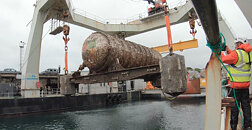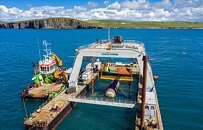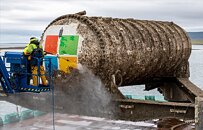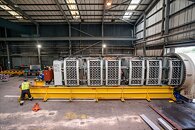Raevenlord
News Editor
- Joined
- Aug 12, 2016
- Messages
- 3,755 (1.16/day)
- Location
- Portugal
| System Name | The Ryzening |
|---|---|
| Processor | AMD Ryzen 9 5900X |
| Motherboard | MSI X570 MAG TOMAHAWK |
| Cooling | Lian Li Galahad 360mm AIO |
| Memory | 32 GB G.Skill Trident Z F4-3733 (4x 8 GB) |
| Video Card(s) | Gigabyte RTX 3070 Ti |
| Storage | Boot: Transcend MTE220S 2TB, Kintson A2000 1TB, Seagate Firewolf Pro 14 TB |
| Display(s) | Acer Nitro VG270UP (1440p 144 Hz IPS) |
| Case | Lian Li O11DX Dynamic White |
| Audio Device(s) | iFi Audio Zen DAC |
| Power Supply | Seasonic Focus+ 750 W |
| Mouse | Cooler Master Masterkeys Lite L |
| Keyboard | Cooler Master Masterkeys Lite L |
| Software | Windows 10 x64 |
Microsoft has announced it considers the result of its underwater data center initiative, named Project Natick, a success. This announcement comes after Microsoft recovered its data center capsule from the seafloor alongside the Orkney Islands after a two-year-long deployment. The self-contained server pod (made up of 12 racks and 864 servers) was filled with nitrogen, and achieved a much lower failure rate - component-wise - compared to traditional onshore data centers. In fact, its failure rate was one-eight that of traditional servers. The absence of oxygen and lower humidity levels (no need to keep air comfortable and breathable for human technicians) may have been deciding factors in this failure rate.
There are some obvious advantages from such an offshore server deployment. For one, all that cold water really helps in cooling down the components inside - there's no need for added expense in cooling solutions. There is also no need for land acquisition or infrastructure development that's typically associated with onshore server sites. The fact that Project Natick was fully powered by renewable energy sources, courtesy of the Orkneys' grid - supplied 100 percent by wind, solar, and experimental green technologies under development at the European Marine Energy Centre. considering its success, it can certainly be expected that Microsoft - and other companies - double down on this type of server deployment.




View at TechPowerUp Main Site
There are some obvious advantages from such an offshore server deployment. For one, all that cold water really helps in cooling down the components inside - there's no need for added expense in cooling solutions. There is also no need for land acquisition or infrastructure development that's typically associated with onshore server sites. The fact that Project Natick was fully powered by renewable energy sources, courtesy of the Orkneys' grid - supplied 100 percent by wind, solar, and experimental green technologies under development at the European Marine Energy Centre. considering its success, it can certainly be expected that Microsoft - and other companies - double down on this type of server deployment.




View at TechPowerUp Main Site








